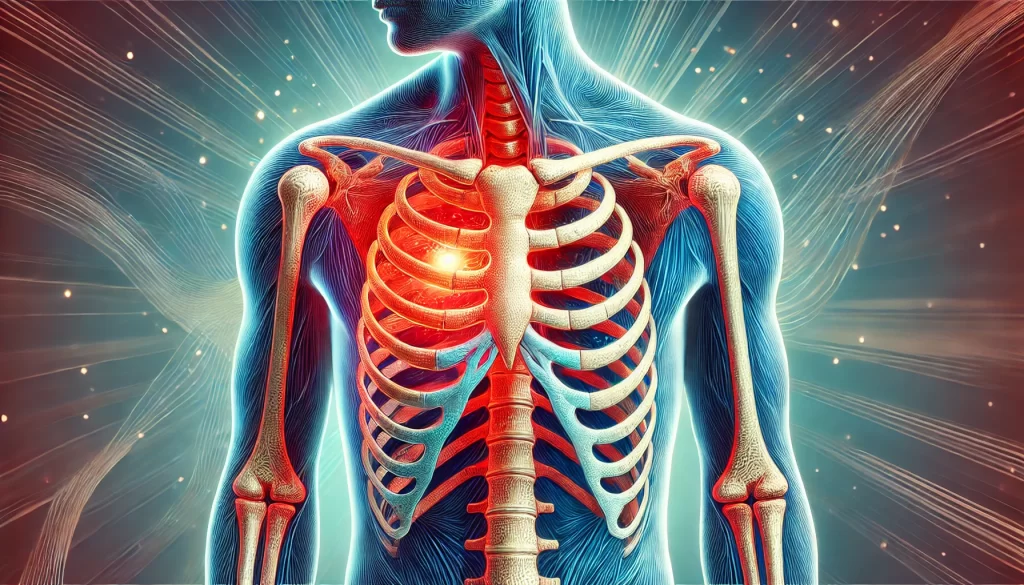Costochondritis: Causes, Symptoms, and Management
Overview of Costochondritis
Costochondritis is the inflammation of the cartilage that connects the ribs to the breastbone (sternum). This condition often results in localized chest pain that can range from mild to severe. The inflammation is typically self-limiting, meaning it may improve on its own over time. However, costochondritis can occasionally flare up or persist, affecting daily activities and causing significant discomfort.
When to Seek Emergency Help
Call emergency services (999) if you or someone you know experiences any of the following symptoms:
- Central chest pain or discomfort that does not subside.
- Pain radiating to the left arm, both arms, neck, jaw, back, or stomach.
- Loss of consciousness, seizures, or fits.
- Difficulty breathing, snoring, or rasping sounds.
- Rapid or very low heart rate.
- Blue or pale tinting of knees, hands, or lips.
- Chest pain accompanied by breathlessness, nausea, sweating, or coughing up blood.
Call 111 if you experience:
- Significant trauma to the chest or ribs within the last 7 days.
- Noticeable changes in the ribcage’s shape (lumps or indentations).
- Worsening shortness of breath or difficulty breathing.
- Pain preventing deep breaths.
- Tingling or burning in the chest, neck, or arms.
Symptoms of Costochondritis
The primary symptom is central chest pain, often described as sharp or aching. Unlike some cardiac issues, costochondritis pain does not typically spread across the chest or into the arms. Pain may worsen with:
- Certain movements or activities, such as wearing a seatbelt or hugging.
- Deep breathing.
- Coughing or sneezing.
Causes of Costochondritis
While the exact cause of costochondritis is often unclear, possible contributing factors include:
- Severe coughing that strains the chest.
- Injury to the chest.
- Physical strain, such as repetitive movement or sudden exertion.
- Respiratory tract infections (RTIs).
Diagnosis
To diagnose costochondritis, a healthcare professional will conduct a physical examination and may ask about your symptoms, medical history, and activities. Further tests may be required to rule out other conditions.
Treatment for Costochondritis
Self-Care and Pain Management:
- Pain Medication: Over-the-counter painkillers, such as paracetamol or ibuprofen, can help reduce discomfort and improve movement.
- Heat Therapy: Use a heat pack with a barrier (like a towel) to avoid direct contact with the skin. Limit heat application to about 15 minutes, with a few hours in between.
- Pacing Activities: Gradually increase daily activities, taking regular breaks to prevent pain flare-ups.
Modified Activity Tips:
- Avoid movements that aggravate pain.
- Take frequent breaks during activities.
- Adjust your position when sitting or lying down.
- Hold objects close to your body when lifting.
- Hug a cushion while coughing to reduce chest pressure.
Keeping Active During Recovery
Maintaining mobility is key. Avoid long periods of rest but pace yourself to prevent excessive pain. Gradually increase activity levels as you progress. Pain levels can guide your activity intensity:
- 0-3: Minimal pain.
- 4-5: Acceptable pain.
- 6-10: Excessive pain; reduce activity accordingly.
Returning to Work and Hobbies
Returning to work depends on your job and symptoms. A phased return may be possible with modified duties. Continue engaging in hobbies as your pain allows, gradually building up to your regular activities.
When to Seek Further Help
If symptoms persist or worsen beyond 8 weeks, consult a healthcare professional. They can provide additional support and explore further treatment options. Remember to prioritize mental well-being during recovery, as it can impact physical healing.







